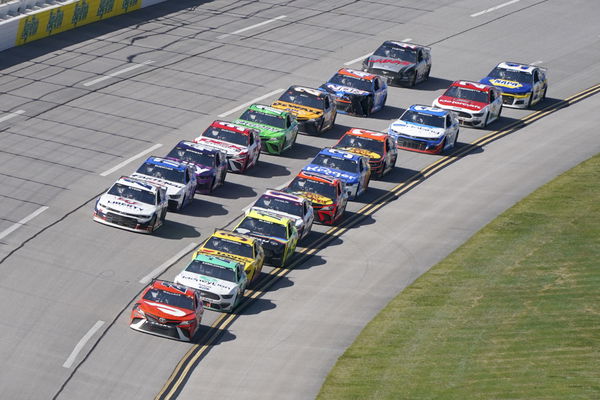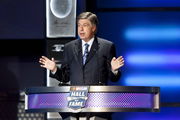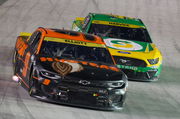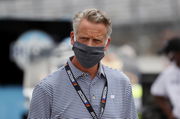
USA Today via Reuters
Apr 25, 2021; Talladega, Alabama, USA; NASCAR Cup Series driver Bubba Wallace (23) leads during the GEICO 500 at Talladega Superspeedway. Mandatory Credit: Marvin Gentry-USA TODAY Sports

USA Today via Reuters
Apr 25, 2021; Talladega, Alabama, USA; NASCAR Cup Series driver Bubba Wallace (23) leads during the GEICO 500 at Talladega Superspeedway. Mandatory Credit: Marvin Gentry-USA TODAY Sports
With constant upgrades, NASCAR’s progression to combat rain on tracks has been rather impressive. Technology has added to convenience, but there was a time when NASCAR waited for the rain to cease. Heavy downpours have led to the cancellation of numerous exciting races in the past. This happened recently when the much-anticipated Firekeepers Casino 400 stood the fury of Mother Nature and had to undergo rescheduling!
The race initially faced a delay due to rain after a few pace laps, with the first drops falling around 2:30 p.m. Despite efforts to continue, the rain returned after 51 laps, postponing the race just after Stage 1. It was then rescheduled for Monday, August 19 at 11 a.m., with the remaining laps televised on USA Network.
Jet dryers were used to dry the track, but a second round of rain complicated efforts, requiring the track to be dried again before resuming the race. While rain and racing might not always be the best friends, it certainly adds to a unique experience, right? Joe Gibbs Racing brings forth an interesting perspective that shows the progression of NASCAR’s rain strategy.
ADVERTISEMENT
Article continues below this ad
Technology casts a spell of hope to combat unfavorable weather
NASCAR introduced new wet weather rules starting August 11th at Richmond Raceway, following two consecutive rain-affected Chicago Street Races. With a 10-15% chance of rain expected during the Richmond weekend, all eyes were on how these updated regulations will help keep the race on track, even in less-than-ideal conditions.
Rain or no rain, the show must go on, right? NASCAR, being an oval racing series, has always found it difficult to manage races during the rain. You must have seen for most times how cars act as dryers for the trackway. This prevalence was more common after the low-flying helicopters did not prove to be an effective solution.
“Rain has always been a big issue with NASCAR, and technology has helped the issue, but it wasn’t always the case. Many different strategies have been used including low-flying helicopters. This was used until Michigan in 1969 when a damaged helicopter had to be removed from the track. From them the strategy has been to use the cars”, Joe Gibbs Racing revealed.
Using cars, often termed “rabbits,” was a common practice. The rabbit would move around the track and then report back about the wet and moisture content of the track. In 1980, it was seen that big trucks with tires dried the trackway by dragging the tires all around. The friction from the tires helped in soaking up the moisture and provided rapid relief.
Consequently, this is when the jet dryers made their sensational debut! Pickup trucks had jet engines strapped to the back, and this eased out the drying of the track! Can you imagine that these engines had the power to pump out heat at 1100 degrees?
- Reports mention that the engine required a minimum of 200 gallons of jet fuel each hour to run smoothly.
- Emergency vehicles often moved around the trackway lap after lap, deriving information about the current condition of the trackway.

USA Today via Reuters
Aug 21, 2022; Watkins Glen, New York, USA; NASCAR Cup Series driver Kimi Raikkonen (91) runs in the rain under the opening pace laps during the Go Bowling at The Glen at Watkins Glen International. Mandatory Credit: Matthew OHaren-USA TODAY Sports
“Fans would watch the Fire Truck 500 as countless vehicles made lap after lap and then in 2013 we finally got the Air Titan. But these were still expensive and insufficient, so one year later we got the Air Titan 2.0”, Joe Gibbs Racing further added.
The Air Titan 2.0 is a smart device that makes the best use of technology and is capable of shooting around the air at the speed of 500 miles per hour. In spite, of these advancements, popular opinions suggest that still, the best way to dry the tracks is with the help of cars. Even the use of wet tires at a pre-decided speed for racing does not seem to be a bad idea!
ADVERTISEMENT
Article continues below this ad
Trending
Can Talladega combat with rain for YellaWood 500?
As all eyes are set on October 6th, YellaWood 500, what measures will Talladega take up in case rain bestows on the tracks? Being the most favorite Superspeedway, using rain tires can never be a good option! The 2.66-long track, having an oval shape, adds to the difficulty. It can take up to 2.5 hours sometimes for the track to completely dry up after a heavy outpour!
Due to the dearth of having any kind of lights, fans might also not be able to witness the charisma of a night race. While small splashes of rain are often under control due to the immediate drying of the track, the real problem arises if there is a major outpour. Fans can bid adieu to these worries as the weather forecast shows rather sunny weather.
ADVERTISEMENT
Article continues below this ad
On Saturday, the maximum temperature was 77 degrees, while on Sunday it is expected to go 90. So no chance of rain as of yet.
The Love’s RV Stop 225 for the NASCAR Craftsman Truck Series showed some brilliant results, with Grant Effinger securing the 1st position. What do you think could be the top 3 names for the YellaWood 500?
Have something to say?
Let the world know your perspective.
ADVERTISEMENT
ADVERTISEMENT
ADVERTISEMENT
ADVERTISEMENT







What’s your perspective on:
Has NASCAR's rain strategy evolution made races more thrilling or taken away the unpredictability factor?
Have an interesting take?